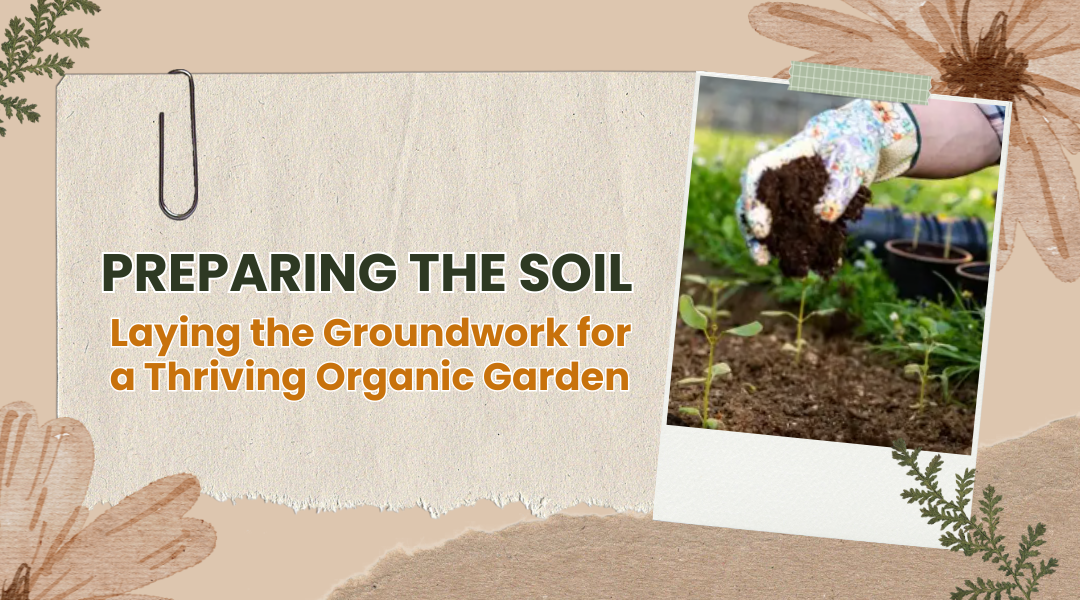The secret to a flourishing garden isn’t just planting seeds—it starts underground. Healthy soil is the foundation of organic success. It nourishes your plants naturally, strengthens their resistance to pests and diseases, and supports a vibrant ecosystem of beneficial organisms. Whether you’re planting directly in your yard, building raised beds, or filling containers, understanding how to prepare and nurture your soil is essential for long-term garden health.
Understanding Your Soil: The First Step
Before you can improve your garden, you need to know what you’re working with. Soil is not just dirt—it’s a living system composed of particles of sand, silt, and clay. Each type behaves differently:
Clay Soil
- Characteristics: Rich in nutrients and moisture-retentive, but prone to compaction and slow to warm in spring.
- Touch Test: Sticky when wet, can be rolled into thin ribbons.
- Tip: Add compost and coarse organic matter to break up heavy clay and improve drainage.
Sandy Soil
- Characteristics: Drains quickly, warms rapidly, but nutrients can leach away.
- Touch Test: Gritty and loose, falls apart easily.
- Tip: Incorporate organic matter to retain moisture and nutrients.
Silt Soil
- Characteristics: Fertile and moisture-holding but can compact easily.
- Touch Test: Smooth when dry, slippery when wet.
- Tip: Add compost and mulch to improve structure and prevent crusting.
Loam Soil
- Characteristics: Ideal for gardening, balancing drainage, fertility, and workability.
- Touch Test: Slightly gritty, slightly sticky, holds together when moist but crumbles easily.
- Tip: Maintain by adding organic matter regularly.
Simple Jar Test for Soil Texture:
- Collect a sample and fill a clear jar halfway with soil.
- Add water to fill the jar, shake thoroughly, and let it settle overnight.
- Observe the layers: sand at the bottom, silt in the middle, clay on top. Organic material may float. This helps you identify your soil type and plan amendments accordingly.
Organic Matter: The Heart of Healthy Soil
No matter your soil type, the single most transformative ingredient is organic matter—especially compost. It:
- Improves clay: Loosens tight particles for better drainage.
- Supports sandy soil: Retains moisture and nutrients.
- Feeds soil life: Provides food for microbes, fungi, and earthworms.
- Supplies steady nutrients: Releases them gradually for plants.
- Buffers pH: Helps balance acidity or alkalinity.
- Reduces compaction: Creates a lighter, friable structure that roots love.
Organic matter is the engine of the soil food web—the network of organisms that make nutrients available to plants naturally.
Making Compost at Home
Turning kitchen scraps and yard waste into nutrient-rich compost is easier than it seems.
Ingredients:
- Greens (Nitrogen-rich): Vegetable scraps, coffee grounds, grass clippings.
- Browns (Carbon-rich): Fallen leaves, straw, shredded newspaper, small twigs.
- Avoid: Meat, dairy, oily foods, diseased plants, and weeds gone to seed.
Methods:
- Open Pile: Layer browns and greens, keep moist like a damp sponge, turn occasionally. Decomposition can take 6 months to a year.
- Compost Bin: Enclosed bins retain heat and moisture for faster composting. Turn as recommended.
- Vermicomposting: Use red wiggler worms in a bin to convert kitchen scraps into nutrient-dense worm castings—perfect for indoor or small-space gardening.
Preparing Garden Beds: In-Ground Planting
For traditional in-ground gardens:
- Clear the Area: Remove weeds or sod. Sheet mulching is an excellent alternative—layer cardboard, compost, and organic matter to suppress weeds and enrich the soil over several months.
- Loosen the Soil: Work the top 8–12 inches gently with a fork or spade; avoid aggressive tilling that can destroy soil structure.
- Add Organic Matter: Spread 2–4 inches of finished compost over the loosened soil.
- Incorporate Lightly: Mix the compost gently into the top few inches.
- Test if Needed: For large plots or suspected deficiencies, consider a soil test to identify pH and nutrient needs.
- Mulch: Cover beds with straw, leaves, or other organic mulch to protect the soil until planting.
Building Raised Bed Soil: The Perfect Mix
Raised beds allow you to design soil from scratch for optimal growth:
- Avoid only topsoil or only compost: Pure topsoil can compact; pure compost can retain too much water.
- Ideal mix:
- 50–60% high-quality topsoil
- 30–40% finished compost
- 10% aeration amendment (perlite, coarse sand, vermiculite, or coco coir)
- Optional layering: Cardboard or coarse organic matter at the bottom, then topsoil-compost blend on top.
- Tip: Leave a few inches at the top to prevent overflow during watering.
Container Gardening: Choosing the Right Potting Mix
Containers need a lightweight, well-draining medium:
- Look for: Coco coir or peat moss for moisture retention, perlite or vermiculite for aeration, compost or worm castings for nutrients.
- Avoid: Dense mixes with uncomposted wood chunks that may rot unevenly.
- Certification: Organic gardeners can look for OMRI-listed mixes to ensure truly organic ingredients.
Conclusion: Laying the Groundwork for Garden Success
Healthy soil isn’t just a medium for plants—it’s a living system that nourishes, protects, and sustains your garden. By understanding your soil type, enriching it with organic matter, and preparing it thoughtfully—whether in-ground, raised beds, or containers—you create a foundation for strong, resilient plants. This careful preparation pays off season after season, yielding abundant harvests, vibrant landscapes, and a thriving ecosystem that supports life above and below ground.
Invest the time now in your soil, and your garden will reward you with long-term vitality, productivity, and the satisfaction of working in harmony with nature.
